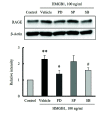HMGB1 increases RAGE expression in vascular smooth muscle cells via ERK and p-38 MAPK-dependent pathways
- PMID: 36039739
- PMCID: PMC9437367
- DOI: 10.4196/kjpp.2022.26.5.389
HMGB1 increases RAGE expression in vascular smooth muscle cells via ERK and p-38 MAPK-dependent pathways
Abstract
The increased expression of receptors for advanced glycation end-product (RAGE) is known as a key player in the progression of vascular remodeling. However, the precise signal pathways regulating RAGE expression in vascular smooth muscle cells (VSMCs) in the injured vasculatures are unclear. Given the importance of mitogen-activated protein kinase (MAPK) signaling in cell proliferation, we investigated the importance of MAPK signaling in high-mobility group box 1 (HMGB1)-induced RAGE expression in VSMCs. In HMGB1 (100 ng/ml)-stimulated human VSMCs, the expression of RAGE mRNA and protein was increased in association with an increase in AGE-induced VSMC proliferation. The HMGB1-induced RAGE expression was attenuated in cells pretreated with inhibitors for ERK (PD98059, 10 μM) and p38 MAPK (SB203580, 10 μM) as well as in cells deficient in ERK and p38 MAPK using siRNAs, but not in cells deficient of JNK signaling. In cells stimulated with HMGB1, the phosphorylation of ERK, JNK, and p38 MAPK was increased. This increase in ERK and p38 MAPK phosphorylation was inhibited by p38 MAPK and ERK inhibitors, respectively, but not by JNK inhibitor. Moreover, AGE-induced VSMC proliferation in HMGB1-stimulated cells was attenuated in cells treated with ERK and p38 MAPK inhibitors. Taken together, our results indicate that ERK and p38 MAPK signaling are involved in RAGE expression in HMGB1-stimulated VSMCs. Thus, the ERK/p38 MAPK-RAGE signaling axis in VSMCs was suggested as a potential therapeutic target for vascular remodeling in the injured vasculatures.
Keywords: HMGB1; MAPK; RAGE; Vascular remodeling; Vascular smooth muscle cells.
Conflict of interest statement
The authors declare no conflicts of interest.
Figures







Similar articles
-
HMGB1 enhances AGE-mediated VSMC proliferation via an increase in 5-LO-linked RAGE expression.Vascul Pharmacol. 2019 Jul-Aug;118-119:106559. doi: 10.1016/j.vph.2019.04.001. Epub 2019 Apr 4. Vascul Pharmacol. 2019. PMID: 30954689
-
High mobility group protein B1 (HMGB1) interacts with receptor for advanced glycation end products (RAGE) to promote airway smooth muscle cell proliferation through ERK and NF-κB pathways.Int J Clin Exp Pathol. 2019 Sep 1;12(9):3268-3278. eCollection 2019. Int J Clin Exp Pathol. 2019. PMID: 31934170 Free PMC article.
-
IL-1β enhances vascular smooth muscle cell proliferation and migration via P2Y2 receptor-mediated RAGE expression and HMGB1 release.Vascul Pharmacol. 2015 Sep;72:108-17. doi: 10.1016/j.vph.2015.04.013. Epub 2015 May 6. Vascul Pharmacol. 2015. PMID: 25956731
-
High-mobility group box-B1 (HMGB1) mediates the hypoxia-induced mesenchymal transition of osteoblast cells via activating ERK/JNK signaling.Cell Biol Int. 2016 Nov;40(11):1152-1161. doi: 10.1002/cbin.10616. Epub 2016 Sep 15. Cell Biol Int. 2016. PMID: 27106169
-
HMGB1/RAGE axis in tumor development: unraveling its significance.Front Oncol. 2024 Mar 1;14:1336191. doi: 10.3389/fonc.2024.1336191. eCollection 2024. Front Oncol. 2024. PMID: 38529373 Free PMC article. Review.
Cited by
-
Relationship Between Serum HMGB1 and RAGE Levels and Restenosis in Type 2 Diabetes Mellitus Patients Complicated With Lower Extremity Vascular Disease: A Retrospective Study.Diabetes Metab Syndr Obes. 2025 Feb 2;18:315-325. doi: 10.2147/DMSO.S496360. eCollection 2025. Diabetes Metab Syndr Obes. 2025. PMID: 39925465 Free PMC article.
-
Biophysically stressed vascular smooth muscle cells express MCP-1 via a PDGFR-β-HMGB1 signaling pathway.Korean J Physiol Pharmacol. 2024 Sep 1;28(5):449-456. doi: 10.4196/kjpp.2024.28.5.449. Korean J Physiol Pharmacol. 2024. PMID: 39198225 Free PMC article.
-
Quantitative Assessment of Intracellular Effectors and Cellular Response in RAGE Activation.Arch Intern Med Res. 2024;7(2):80-103. doi: 10.26502/aimr.0168. Epub 2024 Apr 26. Arch Intern Med Res. 2024. PMID: 38784044 Free PMC article.
-
Targeting RAGE-signaling pathways in the repair of rotator-cuff injury.Mol Cell Biochem. 2025 Apr;480(4):2539-2554. doi: 10.1007/s11010-024-05132-8. Epub 2024 Oct 12. Mol Cell Biochem. 2025. PMID: 39395136 Free PMC article. Review.
-
Protective effect of 6'-Sialyllactose on LPS-induced macrophage inflammation via regulating Nrf2-mediated oxidative stress and inflammatory signaling pathways.Korean J Physiol Pharmacol. 2024 Nov 1;28(6):503-513. doi: 10.4196/kjpp.2024.28.6.503. Korean J Physiol Pharmacol. 2024. PMID: 39467714 Free PMC article.
References
-
- Hreggvidsdottir HS, Ostberg T, Wähämaa H, Schierbeck H, Aveberger AC, Klevenvall L, Palmblad K, Ottosson L, Andersson U, Harris HE. The alarmin HMGB1 acts in synergy with endogenous and exogenous danger signals to promote inflammation. J Leukoc Biol. 2009;86:655–662. doi: 10.1189/jlb.0908548. - DOI - PubMed
-
- Kalinina N, Agrotis A, Antropova Y, DiVitto G, Kanellakis P, Kostolias G, Ilyinskaya O, Tararak E, Bobik A. Increased expression of the DNA-binding cytokine HMGB1 in human atherosclerotic lesions: role of activated macrophages and cytokines. Arterioscler Thromb Vasc Biol. 2004;24:2320–2325. doi: 10.1161/01.ATV.0000145573.36113.8a. - DOI - PubMed
-
- Cai Y, Sukhova GK, Wong HK, Xu A, Tergaonkar V, Vanhoutte PM, Tang EH. Rap1 induces cytokine production in pro-inflammatory macrophages through NFκB signaling and is highly expressed in human atherosclerotic lesions. Cell Cycle. 2015;14:3580–3592. doi: 10.1080/15384101.2015.1100771. - DOI - PMC - PubMed
LinkOut - more resources
Full Text Sources
Research Materials
Miscellaneous

